SLVS973A September 2009 – July 2015 TLC5926-Q1 , TLC5927-Q1
PRODUCTION DATA.
- 1 Features
- 2 Applications
- 3 Description
- 4 Revision History
- 5 Device Comparison Table
- 6 Pin Configuration and Functions
-
7 Specifications
- 7.1 Absolute Maximum Ratings
- 7.2 ESD Ratings
- 7.3 Recommended Operating Conditions
- 7.4 Thermal Information
- 7.5 Electrical Characteristics: VDD = 3 V
- 7.6 Electrical Characteristics: VDD = 5.5 V
- 7.7 Timing Requirements
- 7.8 Switching Characteristics: VDD = 3 V
- 7.9 Switching Characteristics: VDD = 5.5 V
- 7.10 Typical Characteristics
- 8 Parameter Measurement Information
- 9 Detailed Description
- 10Application and Implementation
- 11Power Supply Recommendations
- 12Layout
- 13Device and Documentation Support
- 14Mechanical, Packaging, and Orderable Information
パッケージ・オプション
メカニカル・データ(パッケージ|ピン)
- PWP|24
サーマルパッド・メカニカル・データ
- PWP|24
発注情報
9 Detailed Description
9.1 Overview
The TLC592x-Q1 is designed for LED displays and LED lighting applications with open-load, shorted-load, and overtemperature detection, and constant-current control. The TLC592x-Q1 contains a 16-bit shift register and data latches, which convert serial input data into parallel output format. At the TLC592x-Q1 output stage, 16 regulated- current ports provide uniform and constant current for driving LEDs within a wide range of VF (Forward Voltage) variations. Used in systems designed for LED display applications (that is, LED panels), TLC592x-Q1 provides great flexibility and device performance. Users can adjust the output current from 5 mA to 120 mA through an external resistor, R-EXT, which gives flexibility in controlling the light intensity of LEDs. TLC592x-Q1 is designed for up to 17 V at the output port. The high clock frequency, 30 MHz, also satisfies the system requirements of high-volume data transmission.
9.2 Functional Block Diagram
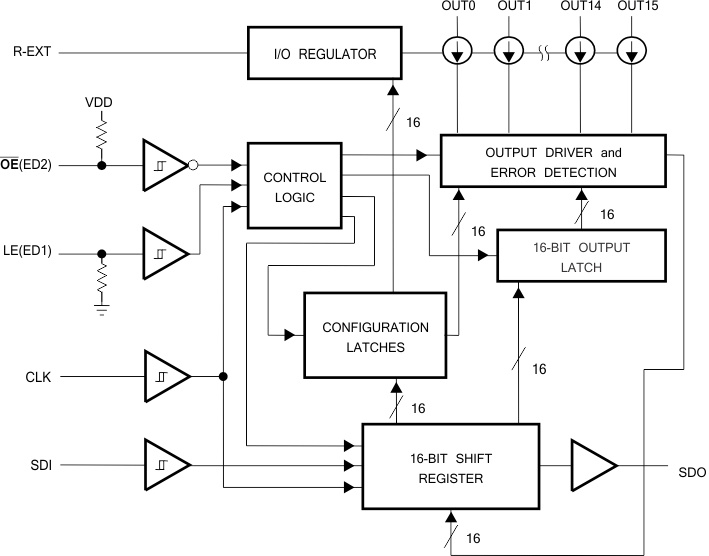
9.3 Feature Description
9.3.1 Open-Circuit Detection Principle
The LED Open-Circuit Detection compares the effective current level IOUT with the open load detection threshold current IOUT,Th. If IOUT is below the IOUT,Th threshold, the TLC592x-Q1 detects an open-load condition. This error status can be read as an error status code in the Special mode. For open-circuit error detection, a channel must be on.
9.3.2 Short-Circuit Detection Principle (TLC5927-Q1 Only)
The LED short-circuit detection compares the effective voltage level VOUT with the shorted-load detection threshold voltages VOUT,TTh and VOUT,RTh. If VOUT is above the VOUT,TTh threshold, the TLC5927-Q1 detects a shorted-load condition. If the VOUT is below VOUT,RTh threshold, no error is detected and the error bit is reset. This error status can be read as an error status code in the Special mode. For short-circuit error detection, a channel must be on.
Table 2. Short-Circuit Detection
| STATE OF OUTPUT PORT | CONDITION OF OUTPUT VOLTAGE | ERROR STATUS CODE | MEANING |
|---|---|---|---|
| Off | IOUT = 0 mA | 0 | Detection not possible |
| On | VOUT ≥ VOUT,TTh | 0 | Short circuit |
| VOUT < VOUT,RTh | 1 | Normal |
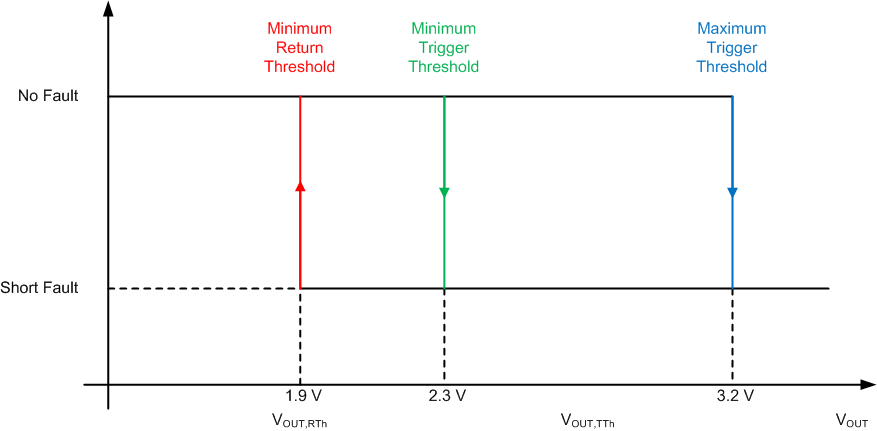 Figure 7. Short-Circuit Detection Principle
Figure 7. Short-Circuit Detection Principle
9.3.3 Overtemperature Detection and Shutdown
The TLC592x-Q1 is equipped with a global overtemperature sensor and 16 individual, channel-specific overtemperature sensors.
- When the global sensor reaches the trip temperature, all output channels are shutdown, and the error status is stored in the internal Error Status register of every channel. After shutdown, the channels automatically restart after cooling down, if the control signal (output latch) remains on. The stored error status is not reset after cooling down and can be read out as the error status code in the Special mode.
- When one of the channel-specific sensors reaches trip temperature, only the affected output channel is shut down, and the error status is stored only in the internal Error Status register of the affected channel. After shutdown, the channel automatically restarts after cooling down, if the control signal (output latch) remains on. The stored error status is not reset after cooling down and can be read out as error status code in the Special mode.
For channel-specific overtemperature error detection, a channel must be on.
The error status code is reset when the TLC592x-Q1 returns to Normal mode.
Table 3. Overtemperature Detection(1)
| STATE OF OUTPUT PORT | CONDITION | ERROR STATUS CODE | MEANING |
|---|---|---|---|
| Off | IOUT = 0 mA | 0 | |
| On On → all channels Off |
Tj < Tj,trip global | 1 | Normal |
| Tj > Tj,trip global | All error status bits = 0 | Global overtemperature | |
| On On → Off |
Tj < Tj,trip channel n | 1 | Normal |
| Tj > Tj,trip channel n | Channel n error status bit = 0 | Channel n overtemperature |
9.4 Device Functional Modes
The TLC5926/TLC5927-Q1 provides a Special Mode in which two functions are included: Error Detection and Current Gain Control. In the TLC5926/TLC5927-Q1 there are two operation modes and three phases: Normal Mode phase, Mode Switching transition phase, and Special mode phase. The signal on the multiple- function pin OE(ED2) is monitored, and when a one- clock-wide short pulse appears on OE(ED2), TLC5926/TLC5927-Q1 enters the Mode Switching phase. At this time, the voltage level on LE (ED1) determines the next mode into which the TLC5926/TLC5927-Q1 switches.
In the Normal Mode phase, the serial data is transferred into TLC5926/TLC5927-Q1 via SDI, shifted in the shift register, and transferred out via SDO. LE (ED1) can latch the serial data in the shift register to the output latch. OE(ED2) enables the output drivers to sink current.
In the Special Mode phase, the low-voltage-level signal OE(ED2) can enable output channels and detect the status of the output current, to tell if the driving current level is enough or not. The detected error status is loaded into the 16-bit shift register and shifted out via SDO, along with the CLK signal. The system controller can read the error status to determine whether or not the LEDs are properly lit. In the Special Mode phase, TLC5926/TLC5927-Q1 also allows users to adjust the output current level by setting a runtime-programmable Configuration Code. The code is sent into TLC5926/TLC5927-Q1 via SDI. The positive pulse of LE (ED1) latches the code in the shift register into a built-in 8-bit configuration latch, instead of the output latch. The code affects the voltage at R-EXT and controls the output-current regulator. The output current can be adjusted finely by a gain ranging from 1/12 to 127/128 in 256 steps. Therefore, the current skew between ICs can be compensated within less than 1%, and this feature is suitable for white balancing in LED color-display panels.
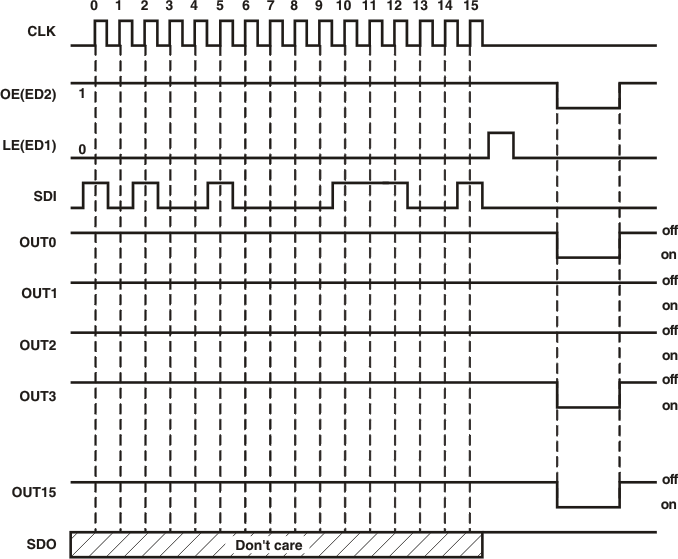 Figure 8. Normal Mode
Figure 8. Normal Mode
Table 4. Truth Table in Normal Mode
| CLK | LE(ED1) | OE(ED2) | SDI | OUT0...OUT15 | SDO |
|---|---|---|---|---|---|
| ↑ | H | L | Dn | Dn...Dn – 7...Dn – 15 | Dn – 15 |
| ↑ | L | L | Dn + 1 | No change | Dn – 14 |
| ↑ | H | L | Dn + 2 | Dn + 2...Dn – 5...Dn – 13 | Dn – 13 |
| ↓ | X | L | Dn + 3 | Dn + 2...Dn – 5...Dn – 13 | Dn – 13 |
| ↓ | X | H | Dn + 3 | off | Dn – 13 |
The signal sequence shown in Figure 9 makes the TLC592x-Q1 enter Current Adjust and Error Detection mode.
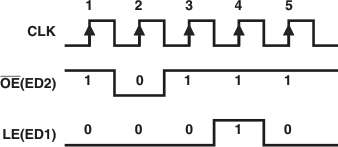 Figure 9. Switching to Special Mode
Figure 9. Switching to Special Mode
In the Current Adjust mode, sending the positive pulse of LE(ED1), the content of the shift register (a current adjust code) is written to the 16-bit configuration latch (see Figure 10).
 Figure 10. Writing Configuration Code
Figure 10. Writing Configuration Code
When the TLC592x-Q1 is in the error detection mode, the signal sequence shown in Figure 11 enables a system controller to read error status codes through SDO.
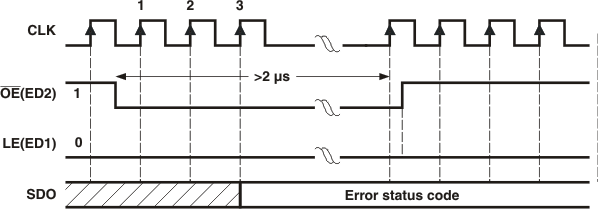 Figure 11. Reading Error Status Code
Figure 11. Reading Error Status Code
The signal sequence shown in Figure 12 makes TLC592x-Q1 resume the Normal mode. Switching to Normal mode resets all internal Error Status registers. OE (ED2) always enables the output port, whether the TLC592x-Q1 enters current adjust mode or not.
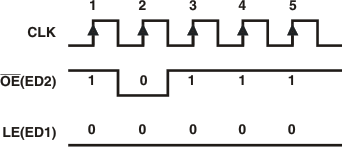 Figure 12. Switching to Normal Mode
Figure 12. Switching to Normal Mode
9.4.1 Operation Mode Switching
In order to switch between its two modes, TLC592x-Q1 monitors the signal OE(ED2). When a one-clock-wide pulse of OE(ED2) appears, TLC592x-Q1 enters the two-clock-period transition phase, the Mode Switching phase. After power on, the default operation mode is the Normal Mode (see Figure 13).
 Figure 13. Mode Switching
Figure 13. Mode Switching
As shown in Figure 13, once a one-clock-wide short pulse (101) of OE(ED2) appears, TLC592x-Q1 enters the Mode Switching phase. At the fourth rising edge of CLK, if LE(ED1) is sampled as voltage high, TLC592x-Q1 switches to Special mode; otherwise, it switches to Normal mode. The signal LE(ED1) between the third and the fifth rising edges of CLK cannot latch any data. Its level is used only to determine into which mode to switch. However, the short pulse of OE(ED2) can still enable the output ports. During mode switching, the serial data can still be transferred through SDI and shifted out from SDO.
NOTE
- The signal sequence for the mode switching may be used frequently to ensure that the TLC592x-Q1 is in the proper mode.
- The 1 and 0 on the LE(ED1) signal are sampled at the rising edge of CLK. The X means its level does not affect the result of mode switching mechanism.
- After power on, the default operation mode is Normal mode.
9.4.2 Normal Mode Phase
Serial data is transferred into TLC592x-Q1 via SDI, shifted in the Shift Register, and output via SDO. LE(ED1) can latch the serial data in the Shift Register to the Output Latch. OE(ED2) enables the output drivers to sink current. These functions differ only as described in Operation Mode Switching, in which case, a short pulse triggers TLC592x-Q1 to switch the operation mode. However, as long as LE(ED1) is high in the Mode Switching phase, TLC592x-Q1 remains in the Normal mode, as if no mode switching occurred.
9.4.3 Special Mode Phase
In the Special mode, as long as OE(ED2) is not low, the serial data is shifted to the Shift Register via SDI and shifted out via SDO, as in the Normal mode. However, there are two differences between the Special Mode and the Normal Mode, as shown in the following sections.
9.4.3.1 Reading Error Status Code in Special Mode
When OE(ED2) is pulled low while in Special mode, error detection and load error status codes are loaded into the Shift Register, in addition to enabling output ports to sink current. Figure 14 shows the timing sequence for error detection. The 0 and 1 signal levels are sampled at the rising edge of each CLK. At least three zeros must be sampled at the voltage low signal OE(ED2). Immediately after the second 0 is sampled, the data input source of the Shift Register changes to the 16-bit parallel Error Status Code register, instead of from the serial data on SDI. Normally, the error status codes are generated at least 2 μs after the falling edge of OE(ED2). The occurrence of the third or later 0 saves the detected error status codes into the Shift Register. Therefore, when OE(ED2) is low, the serial data cannot be shifted into TLC592x-Q1 via SDI. When OE(ED2) is pulled high, the data input source of the Shift Register is changed back to SDI. At the same time, the output ports are disabled and the error detection is completed. Then, the error status codes saved in the Shift Register can be shifted out via SDO bit-by-bit along with CLK, as well as the new serial data can be shifted into TLC592x-Q1 via SDI.
While in Special mode, the TLC592x-Q1 cannot simultaneously transfer serial data and detect LED load error status.
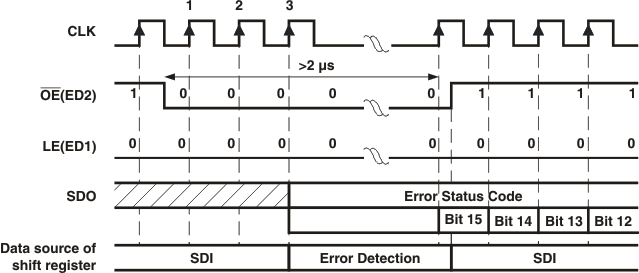 Figure 14. Reading Error Status Code
Figure 14. Reading Error Status Code
9.4.3.2 Writing Configuration Code in Special Mode
When in Special mode, the active high signal LE(ED1) latches the serial data in the Shift Register to the Configuration Latch, instead of the Output Latch. The latched serial data is used as the Configuration Code.
The code is stored until power off or the Configuration Latch is rewritten. As shown in Figure 15, the timing for writing the Configuration Code is the same as the timing in the Normal Mode to latching output channel data. Both the Configuration Code and Error Status Code are transferred in the common 16-bit Shift Register. Users must pay attention to the sequence of error detection and current adjustment to avoid the Configuration Code being overwritten by Error Status Code.
 Figure 15. Writing Configuration Code
Figure 15. Writing Configuration Code